Tooth resorption in dogs is a painful and progressive dental condition that often goes unnoticed until it causes serious discomfort. A veterinary study found that 53.6% of dogs examined showed signs of tooth resorption, even when symptoms weren’t obvious. So, what is tooth resorption in dogs, what causes it, and how can you treat it?
What Is Tooth Resorption in Dogs?
Tooth resorption is when a dog’s body begins to break down and absorb parts of a tooth. It usually starts at the root and can progress toward the crown (the visible part of the tooth). In many cases, the damage happens below the gumline, which makes it hard to detect without X-rays.
This condition is surprisingly common, especially in older dogs, and can affect one or multiple teeth. It’s often confused with other dental issues like cavities or gingivitis, but the underlying process is very different.
What Causes Tooth Resorption in Dogs?
So, what causes tooth resorption in dogs? The exact cause is still unclear, but there are a few suspected triggers. According to the same study, the condition appears more frequently in certain breeds, particularly Boxers (93.3%), Poodles (68.4%), and Dachshunds (61.5%). Age is also a key factor, with older dogs significantly more likely to develop tooth resorption.
Other contributing factors may include:
- Chronic inflammation (such as long-term gingivitis or periodontal disease)
- Tooth trauma or damage
- Genetics or breed predisposition
- Nutritional imbalances or calcium metabolism issues
Keeping up with regular dental care and offering healthy dog food that supports overall wellness may help reduce the risk.
Signs and Symptoms to Watch For
Many dogs don’t show obvious signs of discomfort until the condition has advanced. Look out for:
- Sensitivity when eating or chewing
- Avoidance of hard food or chew toys
- Drooling or blood in the saliva
- Red or inflamed gums around one or more teeth
- Sudden fussiness or irritability
It often overlaps with signs of gingivitis or other oral issues. For guidance on related concerns, check out our tips on dog gingivitis treatment.
Diagnosis and Dog Dental Cleaning
Because most resorptive lesions occur below the gumline, they can be difficult to spot during a regular check-up. The 2010 study found that most lesions were external and linked to gingival inflammation, making proper diagnosis dependent on dental X-rays.
During a professional dog dental cleaning, your vet can identify and assess any hidden areas of concern. Your vet will likely need dental X-rays to confirm the diagnosis.
Treatment depends on how far the resorption has progressed. In early stages, the tooth may still be functional, but advanced cases often require extraction.
Treatment of Tooth Resorption in Dogs
Once a tooth is affected by resorption, it usually can’t be saved. The best approach is to remove the damaged tooth to relieve pain and prevent infection.
Here’s what the treatment of tooth resorption in dogs might involve:
- Full dental exam under anaesthetic
- X-rays to assess the extent of resorption
- Extraction of affected teeth
- Pain relief and recovery support
In some cases, additional follow-up may be needed to check for signs in other teeth. For ongoing care, make sure you know how to brush dog teeth properly and keep up with regular vet visits.
Supporting Long-Term Dental Health
Even if your dog loses a tooth or two, they can still enjoy a happy, healthy life with the right care. Preventative dental routines and the right diet make a big difference.
- Stick to regular dog dental cleaning appointments
- Add dental-friendly treats or supplements to their routine
- Offer a healthy dog food that supports immune and gum health
- Incorporate raw bones and fresh foods into your pets diet
- Watch for signs of discomfort or changes in eating habits
If your pup has bad breath that won’t go away, it might be more than just smelly slobber. You can learn more about bad dog breath and what it could mean for their health.
Help Your Dog Smile Pain-Free
Tooth resorption in dogs can be tricky to catch, but it doesn’t have to be scary. With early diagnosis and the right care, your pup can stay comfortable and pain-free. Think your dog might have dental issues? Ask your vet about an exam and cleaning, especially if they’re showing signs.




